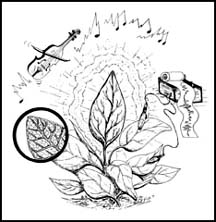PLANT CONSCIOUSNESS: DO PLANTS THINK?
by Joelle Steele

Do plants think? Do they have souls? Feelings? Can they communicate with us? To most scientists, these may seem like ridiculous questions with an obvious answer — NO. But, not all researchers have approached the plant kingdom in a traditional scientific manner and many have arrived at some interesting conclusions in their efforts to prove that plants have consciousness and are not purely sentient beings.
The concept of plants having consciousness dates back thousands of years to the ancient Hindu scriptures. But even as recently as the nineteenth century, Gustav Fechner claimed that plants were spiritually higher than people, just on a lower scale. Fechner justified this by noting that plants readorn themselves from within by self-generating new foliage and flowers, while we mere humans must constantly look outside of ourselves for beautification.
Charles Darwin considered plants capable of thought and also observed a resemblance between the movements of plants and those of some lower lifeforms. He noted that sensations in each were transmitted from one part of the organism to another and speculated that the sensitive radicle of plants acted like the brain of some of the lower animals.

Illustration by Joelle Steele
CRESCOGRAPHS, GALVANOMETERS, AND TOXIC SUBSTANCES
By the turn of the century, renowned physicist Sir Jagadis C. Bose had developed sophisticated monitoring devices, such as the crescograph, to record plant reactions and to substantiate theories of plant consciousness. His crescograph magnified the life processes of plants ten million times and allowed him to observe the reactions of plants to stimuli such as knife cuts, heavy blows, fire, and low voltage electrical current. Bose also attached plants to a galvanometer and proved that excitation is confined to a specific plant tissue. He injected plants with substances such as caffeine, alcohol, chloroform, and strychnine and in doing so discovered reactions and reaction times similar to those of humans.
LIE DETECTORS AND THE POWER OF PRAYER
In the 1960s and early 1970s, everybody seemed to jump on the plant consciousness band-wagon. Russian scientists at the Timiryazev Academy supported Bose's findings with their own research as did Dr. Paul Blondel, of Blake College in San Diego. Cleve Backster, a polygraph specialist, hooked plants up to lie detectors, applied physical, emotional, and psychic stimuli to them, and monitored their reactions. In the Soviet Union, V.N. Pushkin and V.M. Fetisov supported Backster's research with similar experiments of their own using an encephalograph. Dr. Robert N. Miller, tried to prove that plants could be influenced by thought over a great distance by having people pray over a plant from six hundred miles away.
PLANTS LOVE MUSIC
In India, plants were exposed to violin music for half an hour each day, resulting in plants that grew beyond the normal heights of their species. Many such musical studies by university botanists in other countries, including the United States, have consistently shown that plants prefer sound and that it accelerates their growth. Scientists speculate that the sound waves may stimulate the root systems or that they may move the air, thus increasing air circulation. Plants appear to respond equally to anything from classical to hard rock. As a result of these studies, some nurseries regularly pump music into their greenhouses.
KIRLIAN PHOTOGRAPHY
Besides the studies with polygraphs and encephalographs, we have Kirlian photography as visual evidence of the changes of plant "auras" in response to various stimuli. Fofty five years ago, a Russian electrician named Semyon Kirlian was experimenting with a process now known as Kirlian photography. He reproduced, (without a camera or lens), a luminescence emitted by all living things which is invisible to the human eye. These luminescences have been widely studied in plants and are known as bioluminescences, bioplasmic fields, or simply "auras."
Kirlian used his pseudo-photographic process on two identical leaves, one healthy and one diseased. The diseased plant's aura was obviously distorted and more diminished than that of the healthy specimen. In the 1970s, Henry Monteith, an electrical engineer in Albuquerque, New Mexico, had similar results using Kirlian's method. He found that dead leaves gave off only minimal uniform glowing effects, while live leaves emitted brilliant and radiant auras. Kirlian photos reveal marked differences in auras among leaves which are wounded, diseased, insect infested, detached from the plant, dead, exposed to loud/soft music, etc. They reveal that plant auras are at their most striking around mid-morning.
TALKING TO YOUR PLANTS
Many have conducted research in the often controversial area of plant consciousness. However, most can only speculate as to the veracity of their findings. This leaves us with far more questions than answers about the possible human-like qualities of plants. But today, many people insist on talking to their plants on a regular basis, truly believing that they are communicating in a positive manner with their green charges. Even Prince Charles was quoted as saying he talked to his tomato plants. Many respected horticulturists such as George Washington Carver and Burbank believed that plants responded to the spoken word. Dr. John Meyers, an industrial psychiatrist, believes that plant growth is directly related to the emotional quality of words and to the plant's relationship with its human communicator.
Don Juan taught Carlos Castaneda to talk to plants because he believed that they possessed a sensitivity and soul. Are plants capable of such high level forms of consciousness? Science has yet to prove it for sure, but don't let that stop you from having long and meaningful chats with your favorite dieffenbachia, because you never can tell ...

